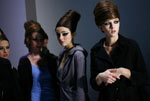Art
The painting of Dwelling in Fuchun Mountain
Updated: 2011-02-25 11:04
By Wang Yumeng (Chinaculture.org)
Burned into Two Halves
In 1650 at Wu Mansion of Yixing, Wu Hongyu still stared at his treasure box at his deathbed. Then, understanding what he wanted to do, his family members brought forth his beloved painting from the box, Dwelling in Fuchun Mountain. He uttered with difficulty, “Burn it!” briefly before he ended his days. He was so fond of the painting that he entrusted his family to burn it as a sacrificial item. The precious painting, which had been passed down for three generations in Wu Mansion, was thrown into a fire. When it hung by a thread, Wu Jingan, Wu Hongyu’s niexe, darted from the crowd, caught it and saved it from burning down. To conceal the fact, she threw another painting into the fire.
 |
Though it survived, Dwelling in Fuchun Mountain was burned into two halves. In 1652, Wu Jigu put the scorched parts together to surprisingly view one river, one mountain and one gully. Then, this part was titled “Remnant Moutain.” The other part was mounted to conceal the burning trace and named as “Master Wu Yong Volume”. As a result the precious painting was separated into two parts.
Copied Painting
Actually, in addition to the one collected by Wu Hongyu, there’s another Dwelling in Fuchuan Mountain which has been passed down for generations. It was a copied version by Shen Zhou in the Ming Dynasty.
During the days of Emperor Cheng Hua in the Ming Dynasty, Shen Zhou got Dwelling in Fuchun Mountain. Deeply addicted to it, he loved it too much to part with it. Time and again he appreciated and copied it and suddenly found one blemish – there’s no inscription by the artist. Blurred at his idea, he entrusted it to a friend for inscription regardless of that such precious treasure like the painting should be stored in secret place. The son of his friend, actuated by greed, sold it out by stealth and lied to Shen Zhou that it was stolen by others.
 |
By chance, Shen Zhou ran into Dwelling in Fuchun Mountain at the market. He was so excited that he hurried home to raise money to buy it. However, when he returned, the picture had already been sold. Shen Zhou was so regretful that he painted a copied version of completely by his memory of it.
The original Dwelling in Fuchun Mountain lost by Shen Zhou was transferred to the great penman, Dong Qichang during the Ming Dynasty. Then, Dong Qichang sold it to the grandfather of Wu Hongyu, Wu Zhengzhi. Due to the fame of the painting, painters during the Ming and Qing dynasties all vied to copy it. In addition to the copied one accomplished by Shen Zhou, there are ten-odd copied versions with recordings. The one by Shen Zhou is now conserved at Beijing Palace Museum.
Master Wu Yong Volume & Zi Ming Volume
Master Wu Yong Volume, though re-mounted and incomplete, still retained the artistic conception of the original painting, which initiated a new mode for Chinese landscape painting. It was ever transferred to Gao Shiqi, Wang Hongxu and An Qi.
In 1745, one roll of Dwelling in Fuchun Mountain was taken to the Palace for the Emperor Qian Long of the Qing Dynasty. He was so fond of it that he even stamped his imperial jade seal on it. Nevertheless, in 1746 he got another one. Actually, the former was fake while the latter was authentic. Nevertheless, when the Emperor Qian Long got the first one, he identified it as the authentic work. As he didn’t want to be humiliated by his false judgment, he invited his subordinates to evaluate the two rolls of Dwelling in Fuchun Mountain. He stuck to his initial perception that the former was the authentic painting while the latter, titled Zi Ming Volume, a fake one. He also asked his subordinates to inscribe a note on the one that he insisted was a fake one. His subordinates all praised Emperor Qian Long’s fine taste in the arts and none of them ever revealed the truth.
The authentic Dwelling in Fuchun Mountain was preserved in Qiangqing Palace for almost two centuries. In 1933, the essential cultural relics at the Forbidden City were transferred to the southern part, first to Shanghai and then to Nanjing. In Shanghai, Xu Bangda closely examined and verified the two rolls of Dwelling in Fuchun Mountain, overruled the former and stated that the one that the Emperor Qiang Long acclaimed was a fake one actually was authentic. Since then, the two rolls have both been conserved at Taibei Palace Museum.
Specials

Kremlin buddies
Dmitry Medvedev and Vladimir Putin inspect Olympic preparations.

Lantern Festival
The Lantern Festival is celebrated across China.

New York Fashion Week
Models line up before a show during New York Fashion Week.